The issue of Climate change and climate variability has affected greater probabilities and risks, further imposing constraints on horticulture production systems.
Climate change might result in price hikes of fruit and vegetables crops.
To quantify the impact of climate change on horticultural crops, we need detailed information on physiological responses of the crop, effect on growth and development, quality and productivity.
Impact on horticulture crops:
Impact of change in technologies like new cultivars and production system management is visible in terms of increased production and productivity, which has recorded more than eleven-fold increase to 282.2 million tonnes 2015-16 from level of 25 million tonnes in 1950-51 (Malhotra 2016b).
To achieve the targeted production of 310 million tonnes of horticultural crops by end of 12 plan (2012-17), vertical growth, through the use of new cultivars, efficient water and nutrients management, effective plant health management coupled with strategies for reduced post harvest losses could be the approach which would need appropriate innovation and investment.
The increased horticulture crops production is to be achieved in the challenges and outcome or results of climate change such as change in seasonal pattern, excessive rain, flood, hailstorm, frost, high temperature and drought leading to extremities.
Reduction in yield may occur due to shortening growing periods, decrease in water availability and poor vernalization.
To quantify the impact of climate change on horticulture crops, we need detailed information on physiological responses of the crop, effect on growth and development, quality and productivity.
The various impacts need to be addressed in a concerted and systematic manner in order to prepare the horticulture sector to face the imminent challenges of climate change.
The rise in temperature would lead to higher respiration rate, alter photosynthesis rate and partitioning of photosynthesis to economic parts.
It could also change or alter the phenology, reduce the crop duration, days to flowering and fruiting, hasten fruit maturity, ripening and senescence.
The sensitivity of individual crops to temperature depends on inherent tolerance and growing habits.
The temperature rise may not be evenly given out or dispers between day and night and between different seasons. In tropical regions an even moderate warming may lead to an out of proportion decrease or reduction in yield.
In high latitudes, crop yields may improve as a result of small increases in temperatures.
In the developing countries, which are predominantly located in lower latitudes or land, temperatures are already closer to or beyond thresholds and further warming would reduce rather than increase productivity.
The impact of climate change is likely to differ with region and type of the crop and is described here for different crop sub-sectors of horticulture.
Fruit Crop:
The unexpected climatic changes or atmospheric change of hot and cold wave conditions have been reported to cause considerable damage to many fruit crops.
In crops like mango and guava, temperature is reported to have an influence on flowering,fruiting and growth of plants also.
Mango is vegetative bias, and this becomes stronger with increase in temperature, thus influencing the flowering phenology and the productivity increases automatically, hence we get the more yield
During the high bloom period, high temperature (35 degree.celsius.) accompanied by low relative humidity (49%) and long sunshine hours resulted in excessive transpiration and dehydration injury to panicles.
Leaf scrunching and twig dying are common signs or symptoms of heat stroke in bearing and non bearing mango plants.
Major observed effects of climate change on mango include early or delayed flowering, multiple reproductive flushes, variations in fruit maturity, abnormal fruit set and transformation of representative buds into vegetative ones.
Plantation and spices crops:
Cashew requires a relatively dry and mild winter (15-20 degree celsius) coupled with moderate dewy during night for profuse flowering.
High temperature (>34.4 degree celsius) and low relative humidity of <20% during afternoon causes drying of flowers resulting in yield reduction.
Unseasonal rain at the ripening stage leads to blackening of nuts as well as of apples on trees.
Cashew experiences severe moisture stress from January to May, which adversely affects its flowering fruits set.
Vegetable Crop:
The Indian climate is dominated by monsoon, responsible for most of the region’s precipitation, poses excess and limited water stress conditions.
Vegetables being succulent are generally sensitive to environmental extremes and high temperature, limited and excess moisture stresses are the major cause of low yield.
Soil water stress at early stages of onion crop growth caused 26% yield loss. In tomato, water stress accompanied by temperature above 28 degree celsius included about 30-45% flower drop in different cultivars.
Chili also suffers drought stress leading to yield loss upto 50-60%. Most vegetables are sensitive to excess moisture stress conditions due to reduction in oxygen in the root zone.
Onion is sensitive to flooding during bulb development with yield loss upto 30-40%. Tomato plants also under flooding conditions accumulate endogenous ethylene, leading to rapid epinastic leaf response.
Tubers crops:
Cool night temperature favors induction of tuberization in potatoes and is inhibited even if temperature is moderately high at night.
Gross photosynthesis rates also reduce at high temperature and drastically reduces tuber yield and biomass production.
Addressing climate change through location-specific Climate smart horticulture:
Climate smart horticulture is not a single specific agricultural technology ao a practice that can be universally applied.
It is an approach that requires site-specific assessments to identify suitable production and technologies and practices to address multiple challenges faced by agriculture and food systems simultaneously and holistically.
Climate change is global, but its nature, extent and magnitude are variable in different regions and locations.
Hence, the issue of climate change and solutions to the problems arising out of it requires local analysis, planning and management.
There is a need to analyze and understand climate change at regional levels in relation to both annual and perennial horticultural crops, which could be managed through innovation, technology evaluation and refinement to provide effective solutions to the problems.
Stimulation Models For Impact Assessment:
In the event of working out adaptation and mitigation strategy, it will be appropriate to utilize modeling tools for impact analysis for various horticultural crops.
Availability and development of good simulation models for horticultural crops is lacking in India probably with exception of potato and coconut.
In tomato and onion crops, the info Crop model has been adapted and the model is being validated for different agro-ecological regions.
Get detailed information about impact of climate change on Horticulture Crops from our khetiguru mobile application.




